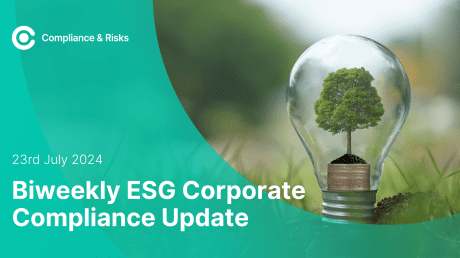
A Cut Ahead: Trending Textile Issues

Closer scrutiny of substances such as PFAS and PIP 3:1 together with the EU Strategy for Sustainable Textiles, Mandatory Digital Labelling of footwear and new standards on the safety requirements for footwear in China are all impacting the industry at large – so how can you stay ahead of regulatory change?
In our new series, we gather some of the most interesting recent inquiries from Compliance & Risks customers around trending textile issues regarding the labeling of apparel, footwear and sporting goods globally, helping you to stay a cut ahead:
Question 1: For the fiber content <5% can be shown as “Other fiber” and cumulative up to 15% “Other fibers.”
Can you share if it needs to show singular or plural form on content labels in the US and in France?
Stacey Bowers, Global Market Access Manager’s answers:
In the US, it is permissible to use either “other fiber” or “other fibers,” as you can see in this guidance from the US FTC here
In France, as in the rest of the EU, Regulation (EU) No 1007/2011 specifies that the term “other fibres” should be used, as per Article 9:
…[A] fibre which accounts for up to 5% of the total weight of the textile product, or fibres which collectively account for up to 15% of the total weight of the textile product, may, where they cannot easily be stated at the time of the manufacture, be designated by the term ‘other fibres’, immediately preceded or followed by their total percentage by weight.
The Article does not address circumstances in which there may be only one “other fiber,” unfortunately; however, we rarely see enforcement of fiber content labeling, unless such labeling is deceptive, such as cases in which a product looks like wool, but is really synthetic, so I would not expect enforcement against the singular “fiber” or plural “fibers.”
Question 2: Is fiber generic name “ELASTOMULTIESTER” allowed for use in Canada?
Stacey Bowers, Global Market Access Manager’s answers:
We recently received this same question from another client and queried Canada’s Competition Bureau, who told us:
The Textile Labelling Act (TLA) requires that prescribed consumer textile articles be labelled using the approved generic fibre names, as found in section 26 of the Textile Labelling and Advertising Regulations (TLAR).
Although certain jurisdictions recognize “elastomultiester” as a fibre and allow it as a generic term for the labelling of textiles, this is not the case in Canada.
Section 40(1)(b) of the TLAR allows a dealer, when disclosing the textile fibre content, to use on a label, descriptive terms that may be shown in addition to the fibre content disclosure as long as they are truthful and accurate (i.e. where they are not false or misleading, per section 5 of the TLA).
For example, “elastomultiester” may be used as a descriptive term, but not in a way that may appear to a consumer that it is a part of the article’s textile fibre content rather than supplemental information.
Section 27(1) of the TLAR sets out the conditions in which an application may be made to the Minister to have a generic name prescribed to a textile fibre. The application requirements are setout in section 27 (2) of the TLAR.
The Act can be found here
The Regulations can be found here
Question 3: How does US Customs enforce fiber identity requirements?
Are they happy to use the latest ISO standard for ISO 2076:2021 rather than the standard which is now out of date listed in the legislation?
If so, are they happy accepting fibre declarations such as 100% Polyester – Recycled Fibres?
Stacey Bowers, Global Market Access Manager’s answers:
16 CFR 303 specifies that manufacturers should follow ISO 2076:2013(E). The standard is “incorporated by reference” in the regulation, as you can see in Article 303.7 here
The Regulation also provides for the use of a manufactured fiber for which no generic name has been established or otherwise recognized by the FTC, in Article 303.8.
Under this process, the manufacturer or producer shall file a written application with the FTC, requesting the establishment of a generic name for such fiber, including:
- The reasons why the applicant’s fiber should not be identified by one of the generic names established by the Commission;
- The chemical composition of the fiber, including the fiber-forming substances and respective percentages thereof, together with samples of the fiber;
- Suggested names for consideration as generic, together with a proposed definition for the fiber;
- Any other information deemed by the applicant to be pertinent to the application, including technical data in the form of test methods; and
- The earliest date on which the application proposes to market or handle the fiber in commerce for other than developmental or testing purposes.
Upon receipt of the application, the Commission will, within sixty (60) days, either deny the application or assign to the fiber a numerical or alphabetical symbol for temporary use during further consideration of such application.
Question 4: Turkey has changed the spelling of its name to “Türkiye.”
When this change takes effect?
Stacey Bowers, Global Market Access Manager and Dila Sen, Global Regulatory & Requirements Compliance Specialist answers:
Dila Sen monitors Turkey and has been paying particular attention to this change, as there have been some ups and downs with regard to its implementation. Here is the timeline, as we know it:
- 4 December 2021: The Turkish President published the Circular on the Use of the Expression of “Türkiye” as a Trademark. According to the Circular, in an effort to strengthen the trademark of Türkiye, the phrase “Made in Türkiye” be used instead of “Made in Turkey” in exported products.
- 16 December 2021: The Turkish Ministry of Trade General Directorate of Product Safety and Inspection sent a letter to the Customs and Foreign Trade Regional Directorates, stating that there would be a transition period until 1 March 2022 for the compulsory use of “Made in Türkiye.”
- 28 December 2021: Another letter was published, in which the transition period was abolished, with no definite deadline given. The letter further indicated that the phrase “Made in Turkey” can be used in export transactions until a second instruction.
- 3 June 2022: The United Nations officially changed the country’s name to “Türkiye,” following receipt of a letter from the Turkish Foreign Minister Mevlüt Cavuşoğlu.
C&R has contacted the Turkish government to confirm when the spelling must be used on product labels.
C&R has also contacted the United States Customs and Border Protection and Office of Textiles and Apparel at the International Trade Administration to determine whether the US government recognizes and requires this spelling.
Updates, including enforcement dates, will be published via C2P daily email alerts.
Question 5: We are getting ready for the 1 January 2023 deadline to mark our personal protective equipment (PPE) with the UKCA mark, rather than the CE mark.
Will the UK permit the use of a sticker for the UKCA mark?
Stacey Bowers, Global Market Access Manager’s answers:
C&R’s Knowledge Partner, Liz Kimber, from RINA, recently added Expert Commentary to C2P in which she described a 20 June 2022 announcement from the UK government, which listed “a range of changes to make it simpler for businesses to apply the new product conformity markings, [which] will surely provide some relief,” including:
- Extending the current labelling allowance to use a sticky label or accompanying document, for marking and information requirements arising out of the change to UKCA marking.
Details of the announcement can be found here
Details of the announcement can be found here
Your Questions Answered
Many of the above questions were submitted and answers were conveyed to Compliance & Risks customers via the “Ask Our Experts” button in C2P.
Clients use AOE to ask about the latest proposed, enacted and amended regulations and mandatory standards applicable to their products and geographies of interest.
When AOE questions can be answered in 30 minutes or less, Compliance & Risks’ subject matter experts answer them at no charge!
Stay up-to-date with our March 2023 textile update, which provides answers about labeling information required for socks in the US and EU markets, mandatory packaging requirements in Turkey, and more. You can also catch up with our previous textile update from January 2023, where we provide answers regarding leather labeling guidance in the US and textile fiber identification laws in France.
To learn more about C2P and how Compliance & Risks’ SMEs can help you with your questions, contact us today.
Meet our Experts

Stacey Bowers, Manager, Global Market Access
Stacey Bowers, MILS, is the Manager of Compliance & Risks’ Global Market Access team.
Stacey is a self-described “law nerd” with nearly 20 years’ experience consulting on international consumer products regulations and standards. She has extensive knowledge of analytical, labeling, safety and testing issues applicable to apparel, cosmetics, food, food contact articles, footwear, giveaways/ incentives/ premiums, home textiles, jewelry, juvenile products and toys.
Stacey and her team of 10 librarians and lawyers produce current, comprehensive and customized research to address strategic business needs for retailers and manufacturers, including entering new geographic markets; facilitating education and training throughout the supply chain; and development of global best practices around regulatory compliance.

Dila Sen, Regulatory and Requirements, Compliance Specialist
Dila is a qualified lawyer in Turkey with more than 10 years’ experience consulting a variety of different companies. As a Global Regulatory & Requirements Compliance Specialist in C&R, she specializes not only in monitoring and analyzing regulatory developments for Turkey, Australia, Slovenia, Rwanda and Azerbaijan but also in researching and monitoring requirements and standards for Turkey, the USA and Australia.
Dila holds a Bachelor of Law Degree (LL.B.) from Yeditepe University, Turkey with a full scholarship and spent one semester at Utrecht University, the Netherlands as an exchange student. She successfully completed her one-year internship in Turkey and obtained her Attorney License from the Turkish Bar Association in 2012. She also holds a B.A. from the Faculty of Communication from Istanbul University (Turkey) and she is a sworn translator from Turkish to English and vice versa.
Lastly, she graduated from the European Master in Law & Economics Programme and she was awarded triple LL.M. degrees from Bologna University (Italy), Ghent University (Belgium), and Haifa University (Israel).
Book Time With Our Team
Learn how C2P can help you stay ahead of global fashion, apparel, luxury and sporting goods regulatory changes and achieve uninterrupted market access.








